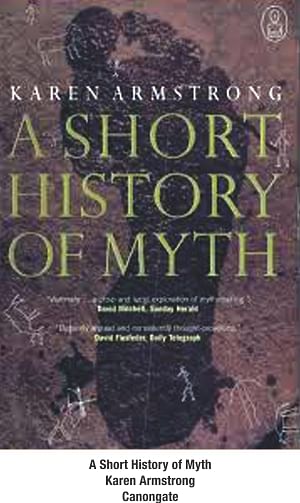Between myth and reality

According to the Oxford dictionary, myth means --- 1. a traditional narrative involving supernatural or imaginary persons and embodying popular ideas on natural or social phenomenon; 2. such narrative collectively; 3. widely held but false notion; 4. A fictitious person, thing or idea; 5. An allegory .
Archaeologists have found weapons, tools and animal bones in the graves of Neanderthals, which indicate that they believed in a future world which is similar to theirs . When they became aware of their mortality they created a counter narrative to come to terms with it . The visible world was not the only reality . From their imagination it was clear that they had ideas which went beyond people's everyday experiences . Human beings invented stories which enabled us to place our lives in a larger setting. From their imagination, mythology and religion were created. This imagination helped scientists to invent new things. Myths and science helped human beings to live more intensely. The graves of Neanderthals taught us a few things, which includes fear of death and extinction. Animal bones indicate that there was sacrifice.
Myth is inseparable from rituals . Myths force us to go beyond our experiences. One day we all have to go to an unknown place. Myth is about the unknown. Myth is about something which initially had no words. Myth is therefore about silence. Myth is not the story told for its own sake, but it helps us to know how we should behave. Sometimes corpses were placed in foetal positions ready for the next world. Mythology places us in another plane which exists alongside our world . The worlds of the gods are the basic theme of mythology. People in ancient days thought that gods, human beings, animals and nature were bound by the same laws. Mythology helped human beings to cope with difficult predicaments. We want to know where we came from, but we have lost the earliest beginnings in the mist of history.
We have created myths about our forefathers which are not facts but current attitudes about customs, neighbours, et cetera. In the pre-modern world people wrote about what it actually meant and not what had actually happened. History has a chronological view. Mythology is art which points beyond history which is timeless in human history. We seek out ecstasy when we feel that we live more intensely. When we fail to find that in temples, churches or mosques we look for them in art, music, sports or drugs. Mythology does not claim to be objective. In difficult situations human beings play with different possibilities. In art we relieve ourselves from the constraints of rules. Myth can be effective as a guide. Ancient people could not leave any written report. But we can learn from indigenous people. Pygmies are still in the hunter age. They believe in myths. They think that they are in harmony with gods, nature and animals. The moon is seen as sacred, as it waxes and wanes. Trees are earthly things and so there is no point in worshipping them.
In the Palaeolithic age (20,000 – 8,000 BCE) the sky was associated with divinity . From the sky, God ruled over the heavens and the earth. But according to Karen Armstrong, myth will not work if it remains connected with the supernatural only. Mythology faded from the lives of people in the west because it was not in touch with the human beings. But height remains sacred. Moses, Christ, Muhammed ascended. The history of ascent goes back to Shamans in the hunting society.
Human beings developed 'Logos' to function logically and scientifically. Logos look forward but myth looks back. Both myth and logos have their limitations and human beings need both. Human beings invented agriculture about ten thousand years ago. Agriculture was not gentle. There was constant battle against the violence of nature. There was drought, storm and famine. In this period the arts and invention of writing helped them to give expression to their mythology.
About four thousand years ago, human beings took another major step forward, when they started to build cities. Civilisation was great but fragile. One city tried to dominate another and as a result there was murder and destruction.
The period between 800 and 200 BCE is described as the Axial Age as it is pivotal to human spiritual development. It marks the beginning of religion. This period also sees the beginning of new capitalist system. Power shifted from the priests and kings to merchants. The post-Axial period started in the 16th century, which is characterised by the end of myths. But there has been a large difference between the first and third worlds. Even in the first world, the 'age of reason' witnessed irrationality at times, for example witchcraft.
It is an insightful book which is highly recommended.
Waheed Nabi is a fellow of the Royal College of Psychiatrists, UK

 For all latest news, follow The Daily Star's Google News channel.
For all latest news, follow The Daily Star's Google News channel. 



Comments